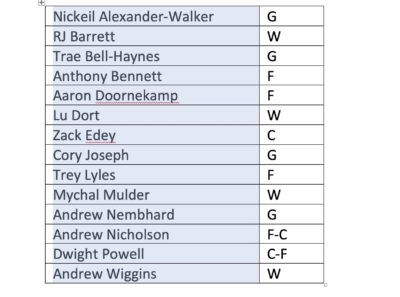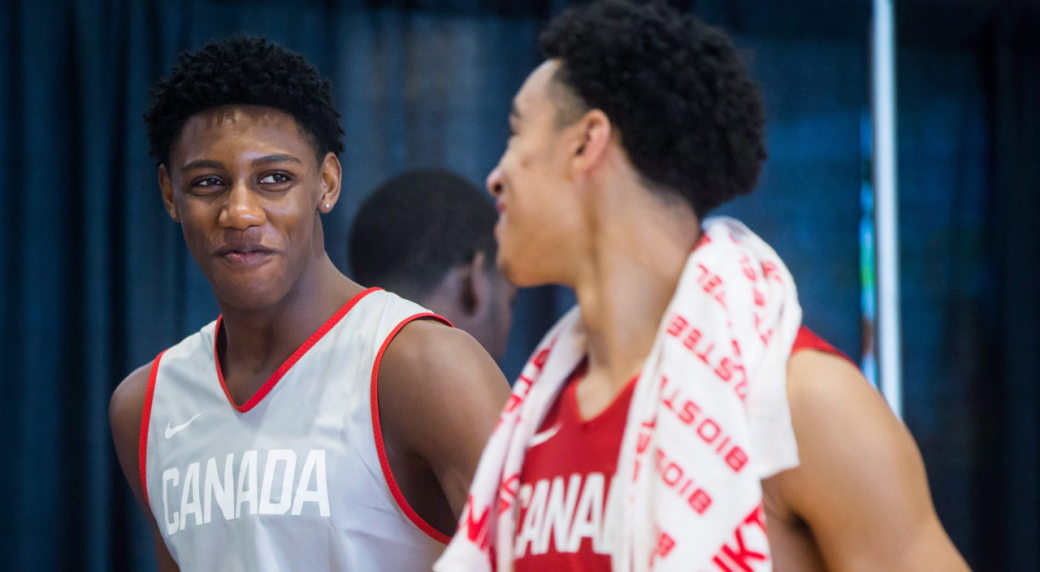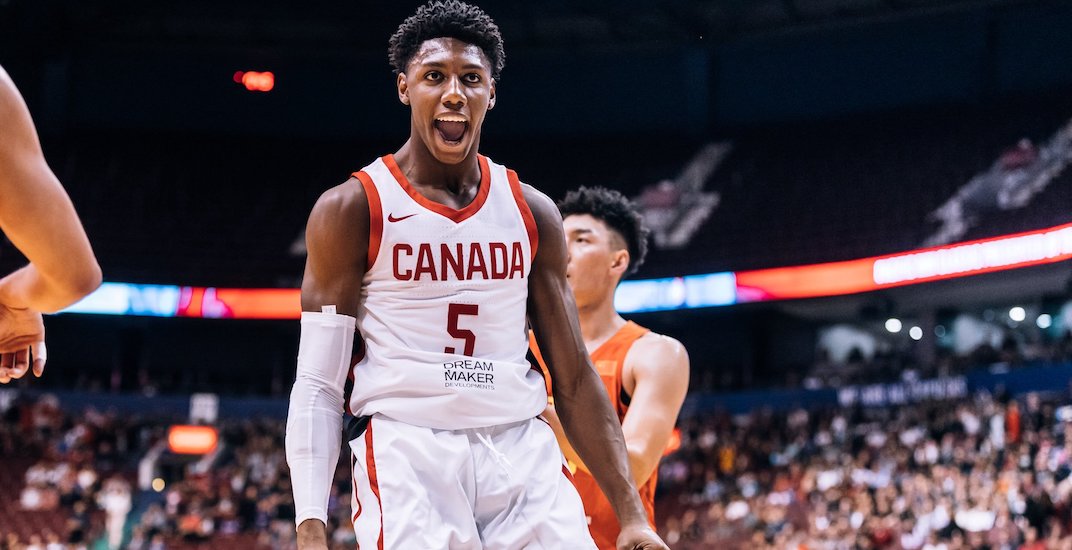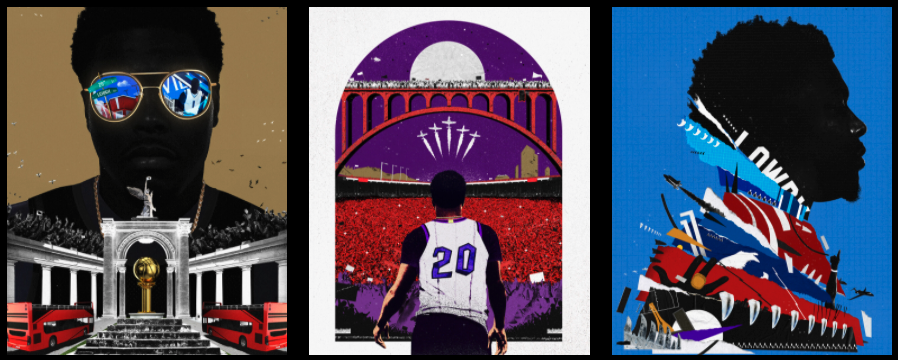Team Canada will begin their journey to qualify for the 2021 Tokyo Olympics on Tuesday, playing on home soil in the FIBA Olympic qualifying tournament in Victoria B.C. If Canada wins, they would qualify for their first Olympic Games since 2000, when Steve Nash led the national team to the Sydney Games. That opportunity begins on Tuesday evening against the No. 6 nation in the world, Greece.
Team Canada enters the tournament ranked as the 21st best country in the world on the men’s side, but that ranking likely sells this team short. While they did finish the 2019 FIBA World Cup 21st in the tournament, with wins against Senegal and Jordan and losses to Germany, Australia, and Lithuania, the nation is bringing its deepest team ever to Victoria in what will be their final opportunity to qualify for the 2021 Olympic Games.
In terms of NBA talent, eight of Team Canada’s 14-man roster that they brought to Victoria currently play in the NBA — by far the most of any nation in the tournament — including the likes of RJ Barrett, Andrew Wiggins, Lu Dort, Nickeil Alexander-Walker, and Dwight Powell. They will need to cut that roster down to 12 before their first game.

While the program was unfortunate to see many Team Canada veterans and rising NBA stars drop out due to injuries, contract situations, and personal reasons — including Kelly Olynyk, Melvin Ejim, Khem Birch, Chris Boucher, Tristan Thompson, Dillion Brooks, and Brandon Clark, as well as Shai Gilgeous-Alexander and Jamal Murray — the team they are bringing is stacked full of guards and wings with NBA experience, and they enter as favourite to win the tournament and go to the Olympics.
(Remember: only the winner of each Olympic qualifying tournament goes to the Olympics. The way the tournament works is as follows: Group A consists of Canada (21st in the world), China (29th), and Greece (6). Group B consists of Turkey (15), Uruguay (45), and Czech Republic (12). The winner of Group A will play the runner-up in Group B, and vice versa, in the semi-finals. The winner of each semi-final will play in the final on July 4th).
I will be in Victoria reporting on the tournament, and you can keep up with all of my work here at Raptors Republic and by following me on Twitter. Here are the five most interesting storylines for Team Canada at the FIBA Olympic qualifying tournament in Victoria:
1. Lack of size
As mentioned above, Team Canada was unfortunate to have several key members of the program drop out of the tournament, some at the last moment, and most of those players happen to be big men.
While they are fortunate to bring some experienced bigs such as Dwight Powell, Anthony Bennett, Andrew Nicholson, and Aaron Doornekamp, they only have two true centers on the roster: Powell and 19-year-old, 7-foot-4 college freshman Zach Edey. While that might not be as big of a problem in the NBA, the FIBA game tends to be slower, more physical, and doesn’t have a three-in-the-key rule, allowing big men to stay stationed under the basket indefinitely. Fortunately, Team Canada has enough skilled guards and wings to make up for their lack of size, but it won’t be easy to keep up in the post and on the boards going small.
Head coach Nick Nurse already talked about his desire to match size-for-size against the opposing nations in the tournament, but that was before losing Melvin Ejim (and Owen Klassen) at the last minute. It will be interesting to see just how often Nurse plays small with Bennett, Nicholson, or Trey Lyles at the five, or if he elects to keep a traditional center in the game for most of the 40 minutes in spite of Powell’s recent achilles injury and Edey’s lack of experience at both the professional and national levels.
2. Defensive versatility
One thing that we know about Nick Nurse is that he likes to mix it up on the defensive end and, even though he talked about matching size-for-size, he has a history of going small, at least in the NBA with the Toronto Raptors.
Team Canada is stock full of defensive-minded wing players that can play together, guard multiple positions, and play in multiple different defensive schemes. I’m talking about players like Andrew Wiggins, who just had the best defensive season of his career in Golden State last season; RJ Barrett, who entered the league as a physical wing defender and who is only getting stronger and better; and Lu Dort, who was Oklahoma City Thunder’s primary wing-stopper this past season and already one of the better and more physical defenders in the NBA. The team also has guards who can stay in front of the ball on the perimeter and effectively navigate screens, including Cory Joseph, Mychal Mulder, Alexander-Walker, and even Trae Bell-Hanyes and Andrew Nembhard.
In fact, defence should be one of the strengths of this team. While they might struggle on the boards if they play small, much like the Raptors did in their small-ball lineups until they learned how to rebound as a team, Team Canada should be able to keep opposing players in front of them and rotate quickly and effectively.
I do wonder how Nick Nurse-y this team will be in terms of mixing up his defensive schemes. From what we’ve seen throughout Nurse’s career, he likes to throw in a zone or a full-court press every once in a while, and he did it with Team Canada at the 2019 FIBA World Cup. In the NBA, he also likes to double-team opposing stars or anyone with a hot-hand, and Team Canada has the personnel to do the same thing while making quick rotations to cover for that aggressive style of play. Still, that type of aggression might be too dependant on team chemistry and could be less suited to the international game, since individual players don’t tend to dominate in the same way that they do in the NBA, so there is a chance Nurse plays it more straight-up.
3. Speed, speed, and how much speed?
How much will Team Canada make it a point to run after stops and score in transition, or will they be happy slowing it down and playing in the half-court? We know that Nurse likes to run, and the team looked best at the 2019 FIBA World Cup when they did exactly that after stops, but did they have a long enough of a training camp — and does the current group have enough experience together — to be an effective team in transition?
Of course, all of the first three storylines are somewhat related, since a lack of size can lead to Team Canada playing smaller and being more switchable and versatile defensively, which can lead to them getting out on the run and scoring in transition. At the same time, each point is unique because no matter how well suited they are to play small or to switch up defensively or to get out on the run after stops, they will need to execute at a high level in order for it to be effective.
When it comes to speed, and specifically scoring in transition after stops, some players are simply better suited to do so than others. In general, the NBA game is played at a faster pace than the international game, but the wealth of NBA experience on the roster should allow Team Canada to deviate from the norm. In fact, the roster is very well suited to run, because on top of having athletic wings such as Barrett and Wiggins, Team Canada also has really quick guards such as Alexander-Walker, Bell-Haynes (an absolute speed demon who dominated the CEBL last summer), Cory Joseph, and Andrew Nembhard, and bigs who can follow the play and shoot the three such as Doornekamp, Bennet, Lyles, and Nicholson.
4. Adjustment to the FIBA rules
As mentioned above, Team Canada’s eight potential current NBA players (on the 14-man roster) represents the most of any team in the tournament (Turkey is second), and it could take some time for some of them to adjust to the FIBA game and to the FIBA rules. Of course, almost all players in the tournament play basketball professionally, but the European game tends to be more similar to FIBA than the NBA game is.
In terms of the style, international basketball tends to be much more physical than the NBA, with physical contact often going uncalled, whether it’s on the jump-shot or on the drive. Plus, the international game tends to be slower than the NBA and three-pointers are somewhat less common, depending on the team. However, Team Canada does seem well suited to shoot lots of threes, especially given that the three-point line is shorter at 6.75 metres vs. 7.24 metres in the NBA.
In terms of the rule differences, each quarter is 10 minutes instead of 12. Plus, international teams under FIBA rules get fewer timeouts than in the NBA, with two in the first-half and three in the second-half, including only two in the final two minutes of the fourth quarter. They also only get one in overtime rather than two. Coaches can call timeouts during a stoppage of play, but not during live action. Also, players foul out on five personal (including technical) fouls instead of six. And teams enter the bonus after four fouls, technicals included.
In terms of stylistic differences, there is no three-in-the-key rule in the FIBA game, meaning defensive players can stay in the painted area for however long they want (this may be part of the reason that there are fewer threes, as big men can stay stationed in the paint and allow their teammates to avoid rotations after drives). Another big difference of the FIBA game is the goaltending rules, as players can touch the ball over the cylinder once the ball strikes the rim, either swatting it away or tapping it in.
Obviously, it could take some time for the players with less experience in the international game to pick up on these rules and stylistic differences. And while Team Canada did have FIBA referees come into their training camp to answer questions about the rules, it will be interesting to watch their important opening match against Greece who, while missing several key players, still bring a ton of international experience to the tournament.
5. Canadian fans!
After months of speculation and push from Team Canada General Manager Rowan Barrett — who finally got FIBA to agree to host a tournament in Canada prior to the COVID-19 pandemic — British Columbia Public Health announced on Friday that they would, in fact, be permitting fans into the Save-On-Foods Memorial Centre in Victoria for games beginning Thursday, July 1.
Only 10 percent attendance will be permitted and, in an arena that normally seats 7,400 people, that means roughly 740 people will be in attendance. Unfortunately, that excludes Canada’s round-robin games, which will take place on Tuesday, June 29th and Wednesday, June 30th. But it does include the tournament semifinals (July 3rd) and final (July 4th).
Of course, 740 fans is not enough to get the arena shaking like it is in some of these American cities during the later rounds of the NBA playoffs, but it should provide a nice home court advantage for Team Canada, especially since most of these fans haven’t been to a live sporting event in years. Even Raptors’ superfan Nav Bhatia will be in attendance.
You can watch all the action on CBC, across its various platforms — including both television and online at CBCSports.ca — as well as on DAZN. The first game is on Tuesday at 7:05pm EST, with Canada taking on Greece.
I will be in Victoria reporting on the tournament, and you can keep up with all of my work here at Raptors Republic and by following me on Twitter. I will have another piece up following the Team Canada opening press conference, scheduled for 1:30pm EST on Monday.



